Q&A – Ask Neil: September 29, 2022
(Please read these instructions carefully.)
Before you post your question, please look at recent issues to see if someone else has already asked it. You might find your answer there.
How to submit your question…
• Click here to post your question.
• After you submit your question, a new window will pop up giving you the address to which you can e-mail a photo to accompany your question. Clear, medium-resolution photos. (Try to avoid low-res thumbnail photos, please, in case I have to zoom in to see things.)
• Please only post your question one time.
• One question per reader, please.
• Please use this only for posting questions – not for standard emails.
• Watch for your answer in the following week’s e-gardens.
• I choose those of greatest general interest. For example, plant IDs seldom make the cut.
• I must have your first name or initials.
• I must have your city or county. (Texas is a very large state.)
QUESTION 1
WHAT IS CAUSING RUPTURES IN ELM STEMS?
Question: What is causing these canker-like spots in the stems of this Allee elm? The areas are dry and crumbly. The tree is 5-6 inches in diameter at its base. Angie S., Deer Park, Harris Co.
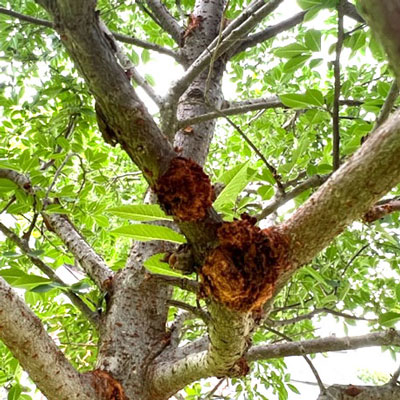
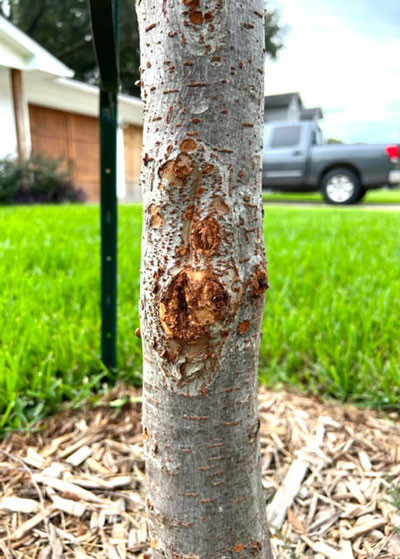
Answer: I have seen this sort of damage done to young trees before, but I didn’t trust my memory. I thought I’d been advised that it was caused by a beetle that had scored the young bark tissues with its mouthparts in the process of laying eggs within the wood. So, I asked two of my friends at Arborilogical Services in Dallas, each of them named Texas Arborist of the Year individually in separate years some time back, for help.
Steve Houser felt that it looked like damage done by squirrels as they sharpened their teeth. He sent a second reply saying that some of it looks like old damage that was in the process of healing.
Russell Peters responded at 5:16 yesterday morning. (He works early!) Here is what he wrote:
“This looks very similar to the work of the flat-headed apple tree borer. The telltale evidence is the over-development of callous, or wound tissue in the picture showing the limbs. I suspect one of the systemic insecticides would work. Safari has a wide list of pests controlled. You could apply it now and watch after leaf-out next spring. Obviously, the visual damage will not go away for a few years but watch for new damage.”
Here is an excellent Fact Sheet from North Carolina State University. In addition to your reading it, it might be a good investment to have a certified arborist watch the tree on site for the next couple of years.
QUESTION 2
WHAT CAUSES HONEYDEW ON DESERT WILLOW?
Question: My young desert willow has honeydew all over its leaves and these small cream-colored balls (eggs?). Please advise. Donna S., Benbrook.
Answer: You wrote “these” as if there might be a photo attached, but I saw none. Honeydew is the excretion of sugary sap that some type of insect has sucked out of a plant’s stems and twigs. This late in the season there is probably little that can or should be done about it. Those leaves will fall fairly soon anyway. It is probably due to aphids, and if any are still present you can probably blast them off with a hard stream of water or kill them with almost any general-purpose garden insecticide. Desert willows are not known to have honeydew issues. You may not see it again.
QUESTION 3
HOW CAN I KEEP GRASS AWAY FROM ROSE PLANTS?
Question: How can I eliminate native grass from around the Drift roses? Can I use Roundup to kill the grass, or would it harm the roses? Would purple wintercreeper be a good groundcover to plant around the roses, or should I use rock or just mulch? Susan D., Brackettville.

Answer: The original Roundup contains only glyphosate (no other active ingredient). You could use it near the roses. However! You must keep it off any desirable green stem or leaf tissue. You would want to use a piece of really stiff cardboard or thin plywood in one hand to lift up the rose stems while you sprayed beneath them with a trigger squeeze bottle with the other hand. Work your way all around each plant, taking care not to let overspray hit the leaves of the nearby plants. The glyphosates are not active in the soil, so you don’t have to worry about the herbicide being carried in through the plants’ roots.
Once you are rid of the existing grass you can choose whether you want gravel or bark as your mulch. Bark looks more natural, so it’s my choice, but many people prefer the permanence of gravel or small rock. I would not suggest a groundcover since Drift roses stay so short. The groundcover would become competitive growing up and into the roses.
QUESTION 4
WHAT HAPPENED TO THE ST. AUGUSTINE WHERE A LIVE OAK WAS CUT DOWN AND ITS STUMP WAS GROUND OUT?
Question: This spot in my yard did have a large live oak. They had it cut down and ground out before we bought the house. The new St. Augustine has started to look like this. What can we do? Paula L., Carrollton.
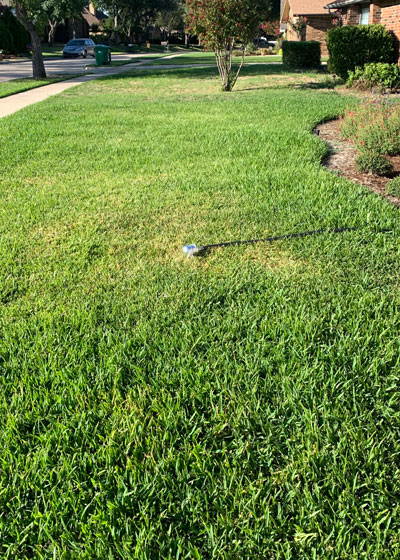
Answer: I see that you are apparently flood-irrigating the area with a water bubbler so I’m assuming it was dry. That would make me think that perhaps there were late-season chinch bugs attacking the grass there. That’s in keeping with the full sun location, so it’s a possibility, although it’s too late in the season to look for them now that things have cooled down. Keep that in mind for next July and if you notice the area looking dry and not responding the watering, check for chinch bugs then. You can see what they look like at the St. Augustine diagnostics page on my website.
That said, it’s also possible that there is still decaying organic matter in the soil and that nitrogen is being used by the microorganisms at the expense of the St. Augustine. That would account for the yellowing. It would not, however, cause the grass to dry out any faster in that one spot unless there were lots of wood shavings left behind after the oak was ground out. Unfortunately, that’s as close as I can come from the photo.
QUESTION 5
WHAT ARE THESE, AND DO I NEED TO GET RID OF THEM?
Question: What are these? I found them in moist, shady areas. The red mushroom-looking one has white, spherical masses of differing sizes below ground with an extensive root system. The other looks like miniature bird nests on top of mulch. Sharon B., McKinney.
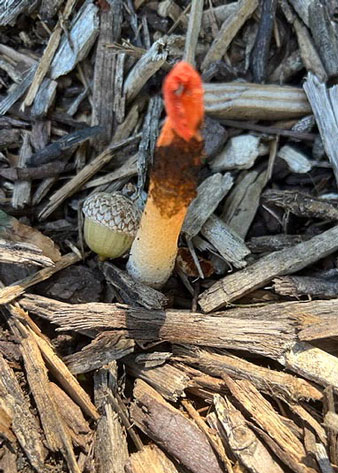


Answer: Both are saprophytic funguses (mushrooms) that live off decaying organic matter. They present no threat to your plants. Do not attempt to eat them, as some mushrooms are deadly poisonous and only trained mycologists (experts in funguses) can tell them apart. No call to action. They will soon run their course.
QUESTION 6
WHAT IS WRONG WITH THIS BERMUDA, AND HOW CAN I CONVERT IT TO ALL ST. AUGUSTINE?
Question: My combination lawn, St. Augustine and bermuda, has a large dead area in the bermuda section. How can I address this? In fact, I would prefer to have all St. Augustine. How can I do that? Shelley B., Keller.

Answer: I am not sure what is wrong with the bermuda. I note that the ornamental sweet potato is thriving, so moisture is obviously available. If this cropped up over the summer, and if this is a low spot in your bermuda, it could be cottony blight (Pythium) damage still visible from weeks ago. That disease attacks bermuda that has been kept too wet and fertilized to excess. Sometimes fertilizer is carried to the low spot of a yard by washing rains or irrigation. Bermuda mites can kill out (or thin out) sections of bermuda, but I don’t see the characteristic clubby runners that come with that pest.
St. Augustine is the more dominant of the two grasses. If you want it to take over the bermuda all you would have to do is to plant plugs of St. Augustine into the lawn in a checkerboard pattern next spring. Set them in on 18-inch centers in April and they would probably cover by late summer.
QUESTION 7
WOULD A TREE-FORM NELLIE R. STEVENS HOLLY BE A GOOD REPLACEMENT HERE FOR A LIVE OAK THAT GOT TOO BIG?
Question: I had a very large live oak removed from my small (26×20 ft.) bermuda lawn. I need a small tree that wouldn’t cause shade issues. Would Nellie R. Stevens holly work? Susan D., Tyler.

Answer: It could, and it would be beautiful. You might also consider one of the larger hybrid hollies like East Palatka. Or the shortest of the southern magnolias, a lovely one called Teddy Bear (grows to 15 ft. tall). (From the “None-of-my-business” department: the new tree ought to be planted either to the far right beyond the edge of the house or between the corner of the house and the right side of the window and out almost as far as the pale grass comes. Don’t center it in the windows. I’m sure you didn’t intend to do that.)
QUESTION 8
HOW OFTEN HAVE YOU SEEN BUTTERFLY WEED AND GOLDENROD BLOOMING TOGETHER?
Question: How often have you seen butterfly weed and goldenrod blooming together? Marvin T., Keller.
Answer: Personally? Never. Butterfly weed (Asclepias tuberosa) blooms in mid-spring. Goldenrod (Solidago sp.) blooms in late summer and mid-fall. Both are lovely garden plants. If you want the look of a milkweed to combine with butterfly weed, there are other options. One attractive one is the taller tropical milkweed, Asclepias currasavica.
QUESTION 9
DO WE NEED TO DO ANYTHING ABOUT THESE GALLS ON OUR YOUNG LIVE OAK?
Question: Our young live oak has a heavy infestation of galls. Do we need to do anything? Deb. R., San Antonio.
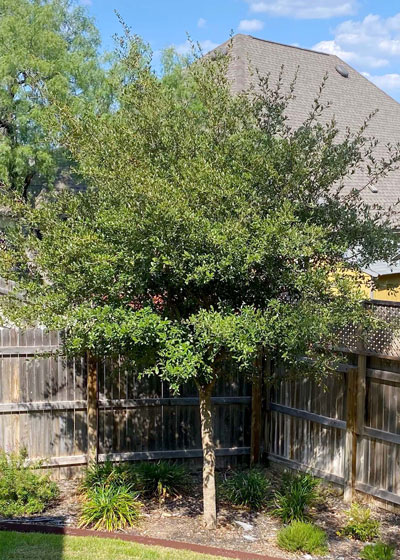
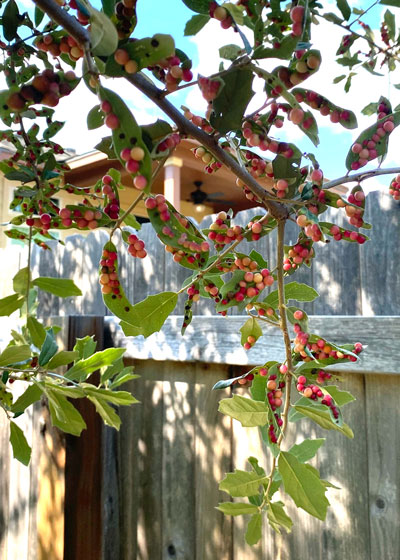
Answer: Many years ago when I worked as a horticulturist for the Texas Agricultural Extension Service (name that was used back then), I asked the late and very great H.A. Turney, Extension entomologist, that same question. His reply was, “You can’t prevent them. You can’t cure them. They’re not going to hurt the tree. You might as well brag about them.” There is no call to action.
QUESTION 10
WHY WON’T ROUNDUP OR ERASER MAX KILL THIS WEED? WHAT WILL KILL IT?
Question: This weed comes back up after I spray both Roundup and Eraser Max. It resembles tumbleweed with its tough stem. Jim H., Grayson.

Answer: Simple explanation (assuming you applied the original Roundup). Both of these products are glyphosates. They are primarily intended to be used to kill grasses and not so much for broadleafed weeds like this. Next time try a broadleafed weedkiller containing 2,4-D, probably in combination with two other broadleafed herbicides. They need to be applied to very active growth, preferably when the weeds are just getting started in their new growth next spring or early summer.
QUESTION 11
DO I NEED TO WORRY ABOUT THIS ON OUR CRAPE MYRTLE?
Question: I found this on our crape myrtle. Is it something I need to worry about? Rand C., Young Co.
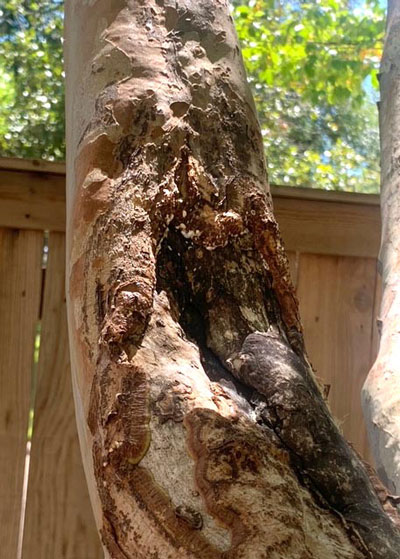
Answer: I believe you’re referring to the crape myrtle bark scale – the white, seemingly immobile insects that are hiding down within the large wound in the trunk. They won’t kill or even do serious harm to the tree, but they will secrete honeydew, and unattractive black sooty mold fungus will grow in the honeydew. To kill the scale next year and therefore to prevent the sooty mold, apply Imidacloprid as a soil drench in mid-May. Here is what we have on the website of our Crape Myrtle Trails of McKinney. If, on the other hand, you are asking about the large area of decayed internal wood, that is very old damage from years ago. The plant is working to heal itself. Given a couple of years more it looks like it will complete the task.
QUESTION 12
WHAT IS HAPPENING TO OUR LARGE NATIVE OAK TREES?
Question: What is happening to our large native oak trees and what can we do to save them? We have not pruned them at the wrong times. Cindy B., North Richland Hills.

Answer: This is skeletonizing done by larvae of sawflies. I have similar damage on a bur oak outside my home office window. As confirmation, here is what North Carolina State University has about sawflies on oaks on their Entomology website.
Your trees are going to be just fine. There is no point in spraying now, just a few weeks before the leaves would be falling anyway. Put your worries away.
